Customer Logins
Obtain the data you need to make the most informed decisions by accessing our extensive portfolio of information, analytics, and expertise. Sign in to the product or service center of your choice.
Customer Logins
ECONOMICS COMMENTARY
Nov 02, 2016
Worldwide manufacturing growth hits two-year high
Global manufacturing expanded at the fastest rate for two years in October, according to PMI survey data, hinting at a welcome resurgence of life in the world's factories at the start of the fourth quarter. Inflationary pressures also picked up to the highest for nearly three years.
Global manufacturing output
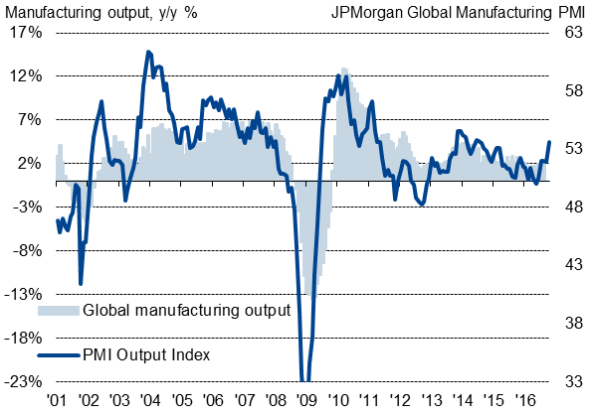
The JPMorgan Global Manufacturing PMI, compiled by Markit from business surveys in over 30 countries, rose to 52.0 from 51.0 in September, its highest since October 2014. The upturn means that the latest survey data are roughly consistent with global manufacturing output rising at a reasonable 4% annual pace.
Both output and new orders grew at the strongest rates for just over two years, and the recent drag from inventory reduction continued to ease. Stocks of both finished goods and inputs showed the smallest declines for over a year.
Global exports continued to rise at only a modest rate, however, acting as a dampener on overall order book and production growth, especially in the emerging markets. While the developed world manufacturing PMI edged up to a 24-month high of 53.0, the emerging market PMI merely rose to 50.9 (albeit a 20-month high).
Broad-based upturn
Key drivers of the overall global improvement were the US and China, where the PMIs hit 12- and 27-month highs respectively, the latter buoyed by output rising in China's factories at the fastest rate for over five years (despite a renewed drop in exports).
The upturn was broad-based, however, as further support came from Europe, where the eurozone PMI hit a 33-month high and the UK continued to register solid growth. The Nikkei PMI for Japan also recorded its best performance for nine months, and the Russian PMI meanwhile lifted to a four-year peak.
Philippines retains top spot
However, the fastest rate of growth (as signalled by the headline PMI) continued to be reported by the Philippines, followed by the Netherlands and Germany, these two runners-up highlighting the relative strength of factory production in northern and central Europe (neighbouring Austria and the Czech Republic were also in the top eight).
India moved into fourth place, helping demote the UK to fifth place. The UK nevertheless remained a strong performer, thanks largely to the weakened pound. Only the Philippines and then Germany reported faster export sales growth than the UK in October.
Worldwide manufacturing PMI rankings
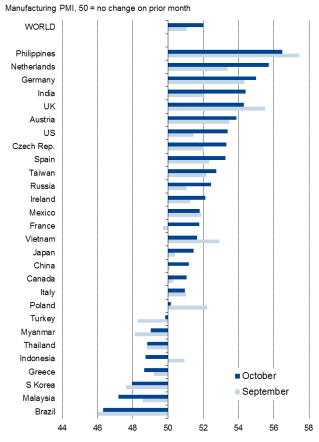
Export rankings
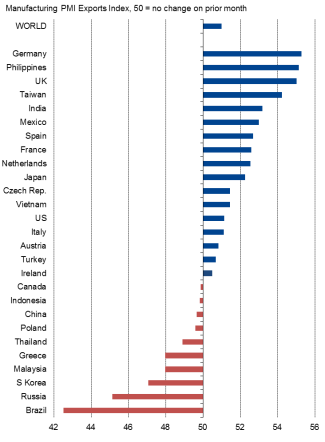
Emerging markets fill lower rankings
Of the 28 countries covered by the Markit-compiled PMI surveys, only eight reported a deterioration in manufacturing conditions. All except Greece were emerging markets.
Brazil once again suffered the steepest downturn, despite seeing its smallest deterioration in nine months, followed by Malaysia and then South Korea, the latter two sitting in contrast to the surging growth recorded in the Philippines and highlighting the marked divergence in manufacturing trends within Asia.
Developed v emerging markets
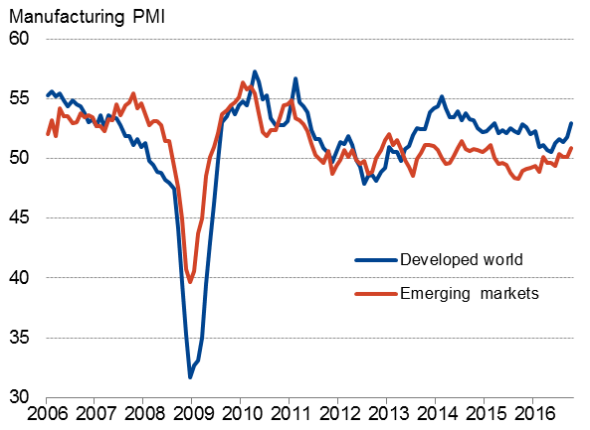
Price pressures near three-year peak
Manufacturing input prices meanwhile rose for a seventh successive month, with the rate of inflation accelerating to the highest since December 2013 (though remaining well below prior survey peaks).
Price pressures
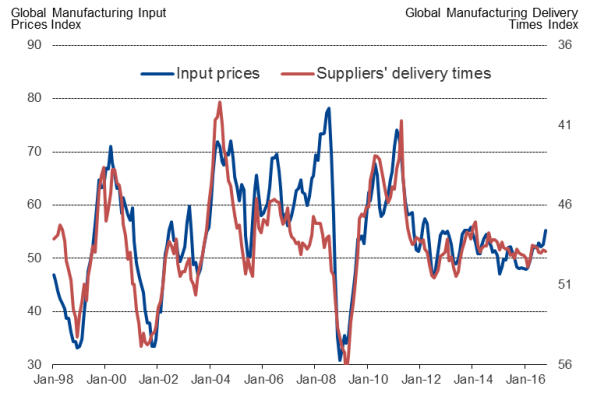
Exchange rates clearly played a major role in driving price divergences. UK firms saw the steepest increase in costs of all countries by a wide margin, as the weaker pound drove up the price of imports. The rise in UK input costs was one of the largest seen since data collection began in 1992.
Conversely, Japan's strong yen meant it was the only country where manufacturers saw prices fall compared to September.
As yet, however, the survey provided scant evidence that prices were being driven up by demand rising faster than supply. Suppliers' delivery times, for example, were largely unchanged, suggesting much of the increase in costs could be explained by higher oil prices rather than a fundamental improvement in suppliers' pricing power.
Input cost inflation rankings
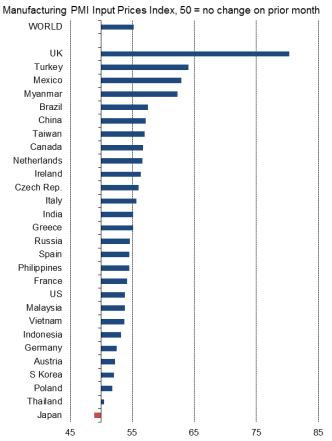
Sources: IHS Markit, JPMorgan, Nikkei, Caixin.
Chris Williamson | Chief Business Economist, IHS Markit
Tel: +44 20 7260 2329
chris.williamson@ihsmarkit.com
{"items" : [
{"name":"share","enabled":true,"desc":"<strong>Share</strong>","mobdesc":"Share","options":[ {"name":"facebook","url":"https://www.facebook.com/sharer.php?u=http%3a%2f%2fstage.www.spglobal.com%2fmarketintelligence%2fen%2fmi%2fresearch-analysis%2f02112016-economics-worldwide-manufacturing-growth-hits-two-year-high.html","enabled":true},{"name":"twitter","url":"https://twitter.com/intent/tweet?url=http%3a%2f%2fstage.www.spglobal.com%2fmarketintelligence%2fen%2fmi%2fresearch-analysis%2f02112016-economics-worldwide-manufacturing-growth-hits-two-year-high.html&text=Worldwide+manufacturing+growth+hits+two-year+high","enabled":true},{"name":"linkedin","url":"https://www.linkedin.com/sharing/share-offsite/?url=http%3a%2f%2fstage.www.spglobal.com%2fmarketintelligence%2fen%2fmi%2fresearch-analysis%2f02112016-economics-worldwide-manufacturing-growth-hits-two-year-high.html","enabled":true},{"name":"email","url":"?subject=Worldwide manufacturing growth hits two-year high&body=http%3a%2f%2fstage.www.spglobal.com%2fmarketintelligence%2fen%2fmi%2fresearch-analysis%2f02112016-economics-worldwide-manufacturing-growth-hits-two-year-high.html","enabled":true},{"name":"whatsapp","url":"https://api.whatsapp.com/send?text=Worldwide+manufacturing+growth+hits+two-year+high http%3a%2f%2fstage.www.spglobal.com%2fmarketintelligence%2fen%2fmi%2fresearch-analysis%2f02112016-economics-worldwide-manufacturing-growth-hits-two-year-high.html","enabled":true}]}, {"name":"rtt","enabled":true,"mobdesc":"Top"}
]}





